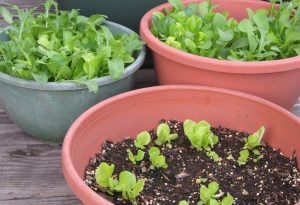Most gardeners have an ideal image of springtime: one sunny day after another, each slightly warmer than the one before, coaxing the crocuses and daffodils and perennials out of the ground in exactly the order promised in the catalog. There’s an occasional light rain, just to keep things moist—but never on the weekend.
Needless to say, that’s not what happens, which makes a greenhouse useful. The basic purpose of a greenhouse is to outsmart the weather, and in springtime, it’s a great tool for getting the garden started on schedule.

It can’t protect the entire garden, but for portable plants, a greenhouse can even out springtime’s wildly swinging temperatures, guard against late frosts, keep rattling thunderstorms from bashing down tender young foliage, and make sure roots don’t drown, even when the soil outside is sopping wet.
Seedlings in the shelter and warmth of a greenhouse can keep growing steadily even when temperature dips or lingering clouds stop outdoor plants in their tracks. If you’ve been shopping, a greenhouse is a perfect place to keep new plants safe until you have a weekend day with the right weather for planting.
Here in the Midwest, it’s been raining for weeks. Low-lying areas are lakes, and low spots in my garden are ponds. Our clay soil is so waterlogged and sticky you could mold pots out of it. It’s way too wet to dig. If I sowed seeds of lettuce and spinach in the garden now, they’d wash away.
The lettuce and spinach might be unlikely to sprout outdoors, but under a clear roof, they can start growing in a wide shallow container that will be easy to move outdoors once the rains stop.
Outdoors, it is not gardening weather. Indoors, it’s a fine time to pot up tender bulbs such as caladiums, crocosmia and elephant ears and start them growing. In mid-May, when it’s safe to move these tender plants out into the garden, they’ll be large enough to star in the container garden.
Many of our favorite vegetables, such as peppers, tomatoes, and cucumbers, are subtropical species that couldn’t handle the chill and the frost risk of even the mildest Chicago spring. These plants need to sprout and begin their growing season with several weeks of indoor warmth. Sure, you can start seeds under lights in the basement, but you can start a lot more seeds in a greenhouse, where they can take advantage of lengthening daylight.
Gardening in a greenhouse is not foolproof. You need to be especially careful of ventilation, so your greenhouse doesn’t actually get too warm from the sunlight of the longer spring days. Hygiene is imperative. And since you’re sheltering your plants from the rain, you’ll need to water. But with a certain attention to detail, even a modest greenhouse can let you get the garden started, whatever the weather.


